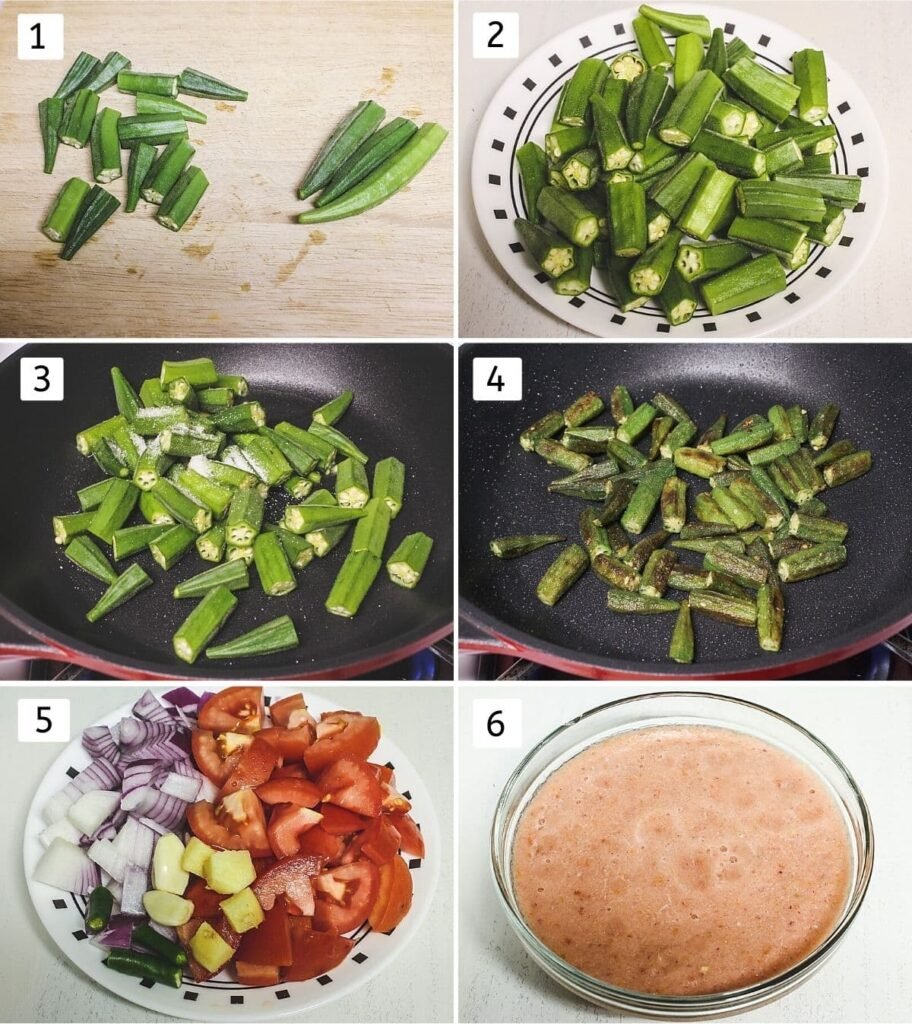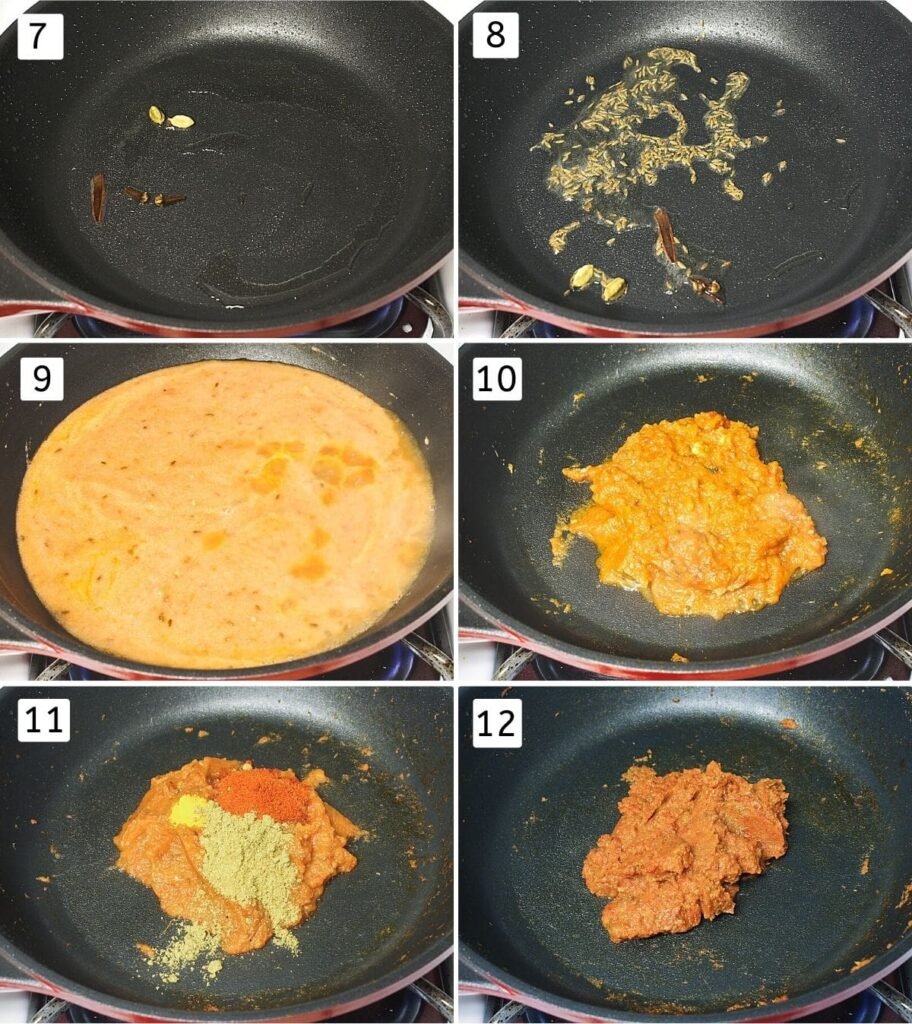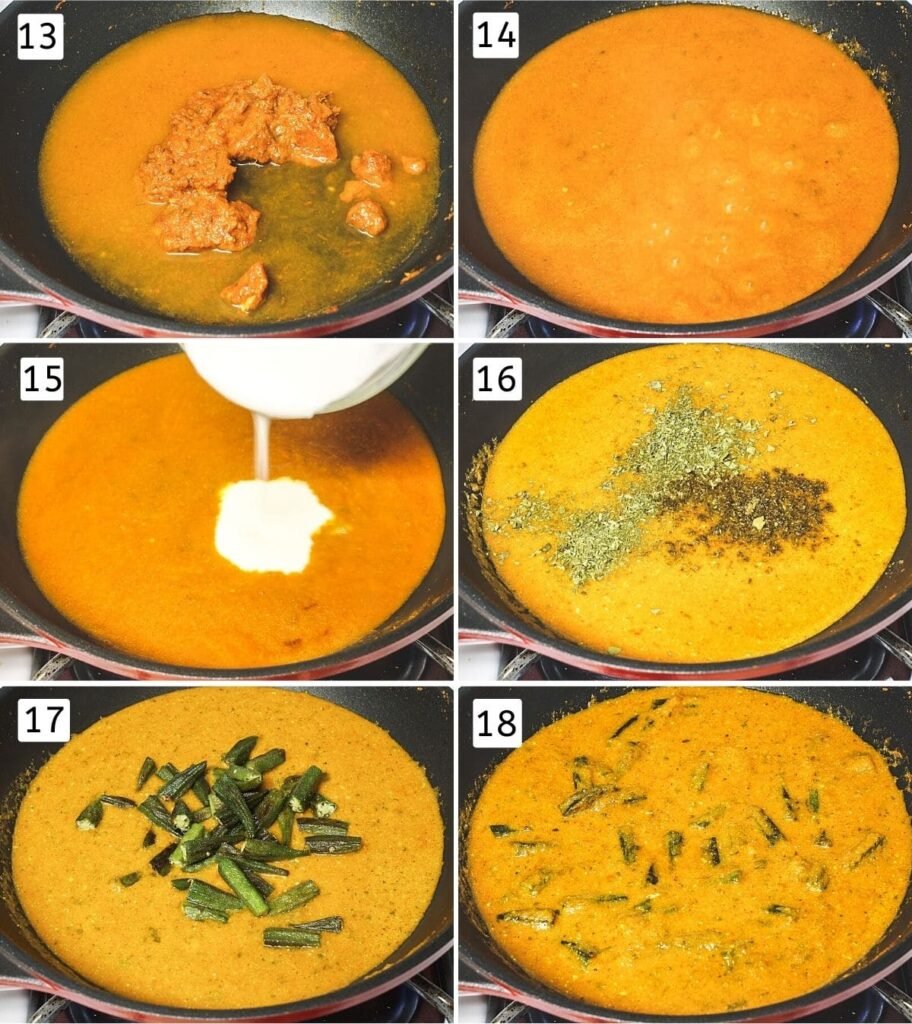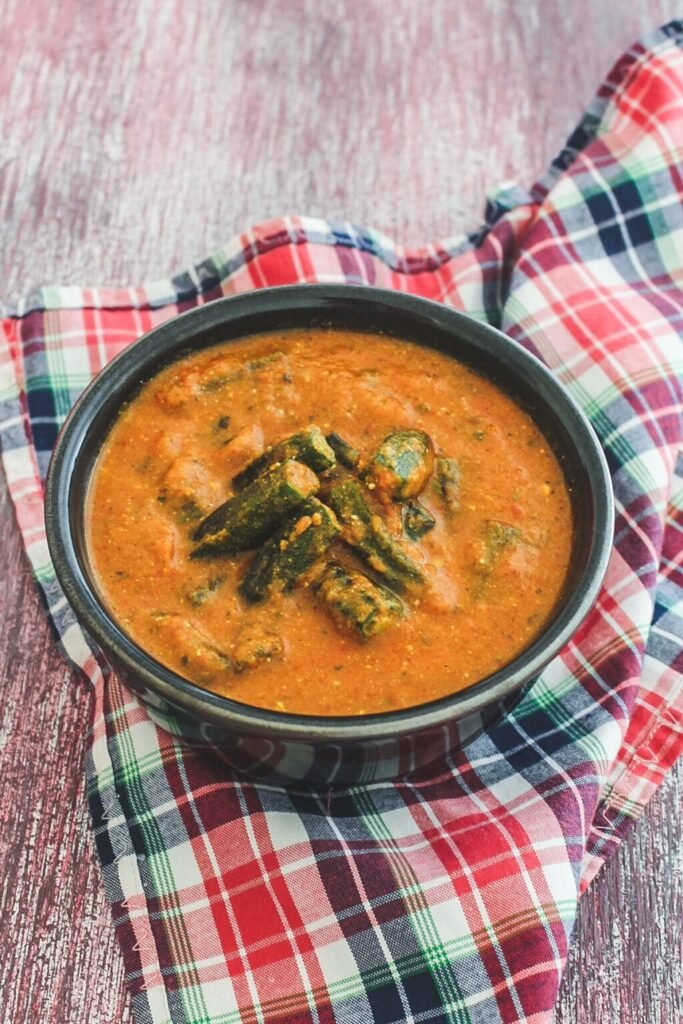Okra curry, also known as bhindi curry, is a flavorful and comforting Indian dish where tender pieces of okra are gently cooked in a spiced, tangy gravy made from onions, tomatoes, and yogurt. This North Indian-style curry strikes a perfect balance of heat and tang, making it a satisfying vegetarian option for everyday meals or special occasions. The dish begins with sautéing the okra until lightly crisped and no longer slimy, allowing it to hold its shape and flavor in the gravy.

The base of the curry is crafted from slow-cooked onions and ripe tomatoes, infused with aromatic spices like cumin, coriander, turmeric, and garam masala. A touch of yogurt not only adds creaminess but also brings a mild tang that complements the natural earthiness of the okra.
This bhindi masala curry pairs beautifully with a variety of Indian breads such as roti, paratha, or even puri, and can also be enjoyed with a bowl of jeera rice or plain steamed basmati. Whether served at a family dinner or packed in a lunchbox, this hearty, wholesome dish is sure to win over anyone who enjoys traditional Indian flavors with a comforting twist.
About This Okra Curry Recipe
- Quick and easy: Preparing this okra curry starts with washing, thoroughly drying, and chopping the okra. Once these steps are complete, the entire curry can be cooked in just about 20 minutes.
- Handle yogurt with care: When adding yogurt to the hot gravy, it’s important to do so gently to prevent it from curdling. Be sure to follow the tips provided to keep the yogurt smooth and avoid any separation.
- Familiar flavors: The sauce in this okra curry offers a creamy texture and a gentle blend of spices, reminiscent of the flavors found in my lauki kofta dish.
- Perfect for okra lovers: If you enjoy bhindi, this dish is sure to become a favorite. Try making this okra curry and share your experience—I’d love to know what you think!
Ingredient Notes

- Okra: You can use either fresh or frozen okra for this curry. Fresh okra tends to have a better texture, but frozen works well too.
- Okra Preparation: If you’re using fresh okra, rinse it well to eliminate any dirt, then drain it thoroughly in a colander. Ideally, allow it to air dry naturally for a few hours—washing it earlier in the day helps. If you’re short on time, gently pat dry the okra with a paper towel. It’s important the okra is fully dry to avoid a slimy, sticky texture when cooked.
- Whole Spices: Adding whole spices like cloves, cinnamon sticks, and green cardamom pods gives the curry a lovely aroma and deeper flavor profile.
- Gravy Base: The gravy starts with a smooth paste made by grinding onions, tomatoes, fresh ginger, garlic, and green chili together. This forms the flavorful foundation of the dish.
- Yogurt: You can use full-fat or low-fat yogurt—both work fine. Whisk the yogurt until creamy and smooth before stirring it into the hot gravy to avoid curdling.
- Spice Powders: Common Indian spices such as turmeric, red chili powder, coriander powder, and garam masala add warmth and mild heat to the curry.
- Kasoori Methi: Dried fenugreek leaves, known as kasoori methi, add a distinctive earthy aroma with a subtle bitterness that elevates the dish’s flavor. Always crush them between your palms before adding. If the leaves are moist—which often happens in humid areas—spread them on a plate and heat in the microwave for about 45 seconds. Let cool, then crush and use.
How To Make Okra Curry?
1) Start with washed and completely dried okra. Trim off both the stem and tail ends, discarding them. Cut the okra into roughly 1-inch pieces. While chopping, the okra tends to release a sticky sap, so wipe your knife clean regularly with a paper towel or kitchen cloth to prevent buildup.
2) Continue chopping all the okra pieces, ensuring you frequently clean your knife. This practice helps minimize stickiness and makes chopping easier.
3) Heat 2 tablespoons of oil in a pan over medium heat. Once the oil is heated, add the chopped okra and a pinch of salt to the pan.
4) Stir well and cook the okra uncovered until it becomes tender. Stir occasionally to ensure even cooking. As it cooks, the okra will reduce in size and develop a deeper color. Once done, transfer it to a plate and set aside.
5) While the okra is cooking, roughly chop onions, tomatoes, fresh ginger, garlic cloves, and green chilies.
6) Blend these ingredients into a smooth paste using a food processor or blender.

7) Using the same pan, warm the remaining oil. When hot, add whole spices such as cloves, cinnamon sticks, and green cardamom pods. Sauté them for about 40 to 60 seconds until fragrant.
8) Next, add cumin seeds and allow them to sizzle briefly.
9) Pour in the prepared onion-tomato paste and add a small pinch of salt (remember that salt was already added to the okra).
10) Cook the mixture on medium heat, stirring occasionally, until the moisture evaporates and the paste thickens.
11) Add turmeric powder, red chili powder, and coriander powder to the thickened gravy.
12) Mix everything well and cook for another minute until oil starts to separate along the edges of the pan.

Finish the Gravy and Combine with Okra
13) Pour in water gradually to adjust the gravy to your desired thickness.
14) Stir the curry well and let it simmer gently for 3 to 4 minutes to blend the flavors.
15) Reduce the heat to the lowest setting, then slowly add whisked yogurt while stirring continuously to prevent curdling. Once combined, raise the heat to medium and allow the curry to simmer gently again.
16) Sprinkle in crushed dried fenugreek leaves (kasoori methi) and garam masala. Stir to combine.
17) Return the cooked okra to the pan.
18) Let the dish simmer for only 2 minutes to allow the flavors to blend perfectly. Avoid cooking longer after adding the okra, as extended heat will make it mushy.

Expert Tips For Bhindi Curry
- Choosing Okra: Select okra that is fresh, firm, and long, with a vibrant deep green color. Avoid any pods that show signs of blemishes, cuts, or oozing internal juices, as these indicate the vegetable is not fresh. Also, try to pick okra pods that have fewer seeds inside for a milder taste and better texture.
- Preventing Sliminess: To minimize okra’s natural stickiness, make sure the pods are thoroughly dried before you begin slicing them. Once washed, allow the okra to air dry completely or carefully pat them dry using a soft kitchen towel. While chopping, the knife tends to become sticky due to the okra’s sap—wipe the blade clean frequently to keep it from sticking. During cooking, stir the okra sparingly, only two to three times. Stirring too often can cause the okra to break apart and release more of its sticky substance, resulting in a slimy texture. Additionally, always cook okra uncovered to allow moisture to evaporate, which helps keep the texture crisp.
- Cooking Texture: When cooking bhindi, aim for a texture that is tender but still firm enough to hold its shape. The okra should stay tender yet firm, without turning overly soft or mushy. This balance ensures the dish remains visually appealing and has a pleasant mouthfeel.
- Tomato Selection: Use ripe tomatoes for the gravy. Unripe tomatoes tend to be sour and can alter the flavor of the curry negatively, making it tangier than desired.
- Adding Yogurt: Yogurt needs careful handling when added to the hot gravy. Always reduce the heat to the lowest setting before stirring in the yogurt, and mix it immediately to prevent curdling. Curdled yogurt not only affects the appearance of the curry but also imparts an unpleasant taste, so this step is crucial for a smooth, creamy gravy.

Serving Ideas For Okra Curry
1. Best Pairing with Indian Breads:
This flavorful okra curry pairs beautifully with Indian flatbreads like roti or paratha. The rich, mildly spiced gravy complements the soft texture of the breads, making it a comforting and satisfying combination.
2. Our Favorite Way to Enjoy:
At our home, we especially enjoy it with ajwain paratha. The carom seeds in the paratha add an extra layer of flavor that goes wonderfully with the tangy-spiced okra curry.
3. Making It a Complete Meal:
To round out the meal, we often serve it with a side of kachumber salad—a refreshing mix of chopped cucumber, tomato, onion, and lemon juice. We also love pairing it with a glass of chilled chaas (spiced buttermilk), which helps balance the warmth of the spices and aids digestion.
4. Serving with Rice (Optional):
Though this dish is traditionally served with roti or paratha, it can also be enjoyed as a side with steamed basmati rice. However, in our personal experience, we find that rice doesn’t always complement okra curry’s texture as well as flatbreads do. That said, food preferences vary, and some people do enjoy it with rice—feel free to try and see what works best for your taste.
5. Versatile and Customizable:
Whether you’re preparing a simple weekday lunch or a wholesome dinner, this bhindi curry is versatile enough to adapt. Add a dollop of ghee on top or serve it with pickle for an extra zing.
